Vadodara
Vadodara (Gujarati pronunciation: [ʋəˈɽodəɾɑː]), formerly also known as Baroda, is the third largest city in the Indian state of Gujarat. It is the administrative headquarters of Vadodara District and is located on the banks of the Vishwamitri river, 141 kilometres (88 mi) from the state capital Gandhinagar. The railway line and NH 8 that connect Delhi and Mumbai pass through Vadodara. The city got its name because of the copious amount of Banyan(Vad) Trees present here. The city is also famous as Sanskari Nagari and Kala Nagari (the city of art)[6] of India.
Vadodara Baroda | |
|---|---|
| Vadodara Sam | |
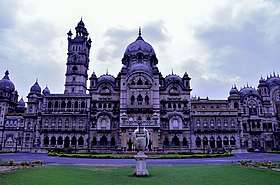 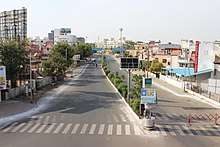  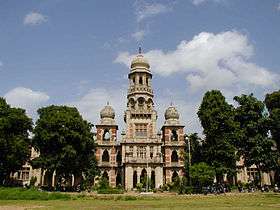 Clockwise from top: Lakshmi Vilas Palace, Saradar Patel Planetarium, Maharaja Sayajirao University of Baroda, Downtown Vadodara | |
| Nickname(s): Sayaji Nagari (City of Sayajirao Gaekwad), Sanskari Nagari (Cultural City), Baroda (old name) | |
 Vadodara Location of Vadodara in Gujarat | |
| Coordinates: 22°18′N 73°12′E | |
| Country | |
| State | Gujarat |
| District | Vadodara District |
| Zone | 4[1] |
| Ward | 25[1][2] |
| Vadodara Municipal Corporation | Established 1950 |
| Government | |
| • Body | VUDA, VMSS |
| • Mayor | Jigeesha Sheth |
| • Municipal Commissioner | Nalin Upadhyay |
| Area | |
| • Total | 176.67 km2 (68.21 sq mi) |
| Area rank | 18 |
| Elevation | 32 m (105 ft) |
| Population (2011)[3] | |
| • Total | 1,822,221 [3] |
| • Rank | 20th (3rd in Gujarat State) |
| Demonym(s) | Barodian |
| Time zone | UTC+5:30 (IST) |
| PIN | 390 0XX |
| Telephone code | (91)265 |
| ISO 3166 code | ISO 3166-2:IN |
| Vehicle registration | GJ-06 (Urban)/GJ-29 (Rural) |
| Largest city | Ahmedabad |
| Nearest city | Bharuch, Anand |
| Literacy Rate | 94.5% |
| Legislature type | Municipal Corporation |
| Legislature Strength | 84[1] |
| Lok Sabha constituency | 1[4] |
| Vidhan Sabha constituency | 13[5] |
| Climate | Tropical savanna (Köppen: Aw) |
| Planning agency | 1 (VUDA) |
| Distance from Gandhinagar | 126 kilometres (78 mi) NE (Rail & Air) |
| Distance from Mumbai | 395 kilometres (245 mi) S (Rail & Air) |
| Distance from Ahmedabad | 100 kilometres (62 mi) NW (Road) |
| Website | www |
The city is known for the Lakshmi Vilas Palace, the residence of Baroda State's Maratha royal family, the Gaekwads, of the Gaekwad Dynasty. It is also the home of the Maharaja Sayajirao University of Baroda.[7]
History
Etymology
.jpg)
The city used to be called Chandanavati after the rule of Raja Chandan of the Dodiya Rajputs. The capital was also known as Virakshetra or Viravati (Land of Warriors). Later on, it was known as Vadpatraka or Vadodará, which according to tradition is a corrupt form of the Sanskrit word vatodar meaning in the belly of the Banyan tree. It is now almost impossible to ascertain when the various changes in the name were made; but early English travellers and merchants mention the town as Brodera,[8] and it is from this that the name Baroda is derived. In 1974, the official name of the city was changed to Vadodara.
In 1907, a small village and township[9] in Michigan, United States, were named after Baroda.
Old Ankotakka
It is believed that early man lived on the banks of the Mahi River, which formed the floodplain during that age.[10] The movements of these hunter-gatherers, living on the banks of the river, grubbing the roots and killing animals with crude stone tools made out of the cobbles and pebbles available on the river bank, were necessarily controlled by the availability of convenient raw materials for their tools.
Recent history
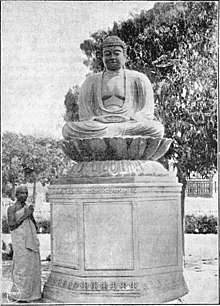
Baroda State was a former Indian Princely State. Vadodara's more recent history began when the Maratha general Pilaji Gaekwad conquered Songadh from the Mughals in 1726. Before the Gaekwads captured Baroda, it was ruled by the Babi Nawabs, who were the officers of the Mughal rulers. Most notably, from 1705–1716, Sardar Senapati Khanderao Dabhade led the Maratha Empire forces in Baroda. Except for a short period, Baroda continued to be in the reign of the Gaekwads from 1734 to 1948. Initially detailed to collect revenue on behalf of the Peshwa in Gujarat, Pilaji Gaekwad remained there to carve out a kingdom for himself. Damajirao, who was son and successor of Pilaji Gaekwad, defeated the Mughal armies and conquered Baroda in 1734. His successors consolidated their power over large tracts of Gujarat, becoming easily the most powerful rulers in the region.
After the Maratha defeat in the Third Battle of Panipat in 1761, control of the empire by the Peshwas weakened as it became a loose confederacy, and the Gaekwad Maharajas ruled the kingdom until it acceded to Independent Republic of India in 1949. In 1802, the British intervened to defend a Maharaja that had recently inherited the throne from rival claimants, and Vadodara concluded a subsidiary alliance with the British that recognised the Kingdom as a Princely state and allowed the Maharajas of Baroda internal political sovereignty in return for recognising British 'Paramountcy', a form of suzerainty in which the control of the state's foreign affairs was completely surrendered.
The golden period in the Maratha rule of Vadodara started with the accession of Maharaja Sayajirao III in 1875.
Geography
Vadodara is located at 22.30°N 73.19°E in western India at an elevation of 39 metres (128 ft). It is the 18th-largest city in India with an area of 235 square kilometres (91 sq mi) and a population of 2.1 million, according to the 2010–11 census. The city sits on the banks of the Vishwamitri River, in central Gujarat. The Vishwamitri frequently dries up in the summer, leaving only a small stream of water. The city is located on the fertile plain between the Mahi and Narmada Rivers. According to the Bureau of Indian Standards, the cosmopolis falls under seismic zone-III, in a scale of I to V (in order of increasing proneness to earthquakes).[11]
Climate
Despite the roughly 800 mm of precipitation that the city receives annually, Vadodara features a semi-arid climate (BSh) under Köppen's Climate classification due to the area's high potential evapotranspiration. There are three main seasons: Summer, Monsoon and Winter. Aside from the monsoon season, the climate is dry. The weather is hot during March to July, when the average maximum is 45 °C (113 °F), and the average minimum is 23 °C (73 °F). From November to February, the average maximum temperature is 30 °C (86 °F), the average minimum is 15 °C (59 °F), and the climate is extremely dry. Cold northerly winds are responsible for a mild chilly days in January. The southwest monsoon brings a humid climate from mid-June to mid-September. The average rainfall is 93 cm (37 in), but infrequent heavy torrential rains cause the river to flood[12] like the 2005 Gujarat flood or the 2008 Indian floods which were catastrophic.[13]
The highest recorded temperature was 46.7 °C (116.1 °F) on 11 May 1960 crossed with 48.0 °C (118.4 °F) on 19 May 2016,[14] while the lowest recorded temperature was −1.1 °C (30.0 °F) on 15 January 1935.[15]
| Climate data for Vadodara | |||||||||||||
|---|---|---|---|---|---|---|---|---|---|---|---|---|---|
| Month | Jan | Feb | Mar | Apr | May | Jun | Jul | Aug | Sep | Oct | Nov | Dec | Year |
| Record high °C (°F) | 36.2 (97.2) |
41.7 (107.1) |
44.4 (111.9) |
45.9 (114.6) |
48.0 (118.4) |
45.6 (114.1) |
40.6 (105.1) |
37.9 (100.2) |
41.1 (106.0) |
42.1 (107.8) |
39.6 (103.3) |
36.8 (98.2) |
48.0 (118.4) |
| Average high °C (°F) | 29.5 (85.1) |
31.9 (89.4) |
36.2 (97.2) |
39.2 (102.6) |
40.1 (104.2) |
36.8 (98.2) |
32.5 (90.5) |
31.4 (88.5) |
33.0 (91.4) |
35.5 (95.9) |
33.4 (92.1) |
30.7 (87.3) |
34.2 (93.5) |
| Average low °C (°F) | 12.5 (54.5) |
14.2 (57.6) |
18.4 (65.1) |
23.0 (73.4) |
26.6 (79.9) |
27.0 (80.6) |
25.8 (78.4) |
25.0 (77.0) |
24.5 (76.1) |
21.4 (70.5) |
16.9 (62.4) |
13.7 (56.7) |
20.8 (69.4) |
| Record low °C (°F) | −1.1 (30.0) |
1.7 (35.1) |
6.7 (44.1) |
11.7 (53.1) |
18.9 (66.0) |
20.2 (68.4) |
21.1 (70.0) |
22.2 (72.0) |
18.9 (66.0) |
11.7 (53.1) |
7.2 (45.0) |
3.3 (37.9) |
−1.1 (30.0) |
| Average precipitation mm (inches) | 2.2 (0.09) |
0.7 (0.03) |
0.7 (0.03) |
1.4 (0.06) |
6.1 (0.24) |
118.9 (4.68) |
274.6 (10.81) |
242.4 (9.54) |
124.2 (4.89) |
26.4 (1.04) |
1.3 (0.05) |
3.7 (0.15) |
802.6 (31.61) |
| Average rainy days | 0 | 0 | 0 | 0 | 0 | 9 | 14 | 11 | 7 | 3 | 1 | 0 | 45 |
| Average relative humidity (%) | 45 | 43 | 35 | 33 | 49 | 67 | 80 | 75 | 73 | 62 | 58 | 54 | 56 |
| Source 1: India Meteorological Department (1952–2000)[16] | |||||||||||||
| Source 2: Weatherbase (Avg. rainy days) | |||||||||||||
Economy
In Vadodara various large-scale industries such as Indian Oil Corporation(IOCL), Gujarat State Fertilizers & Chemicals (GSFC), Vadodara Manufacturing Division(VMD)(Formerly IPCL) of Reliance Industries Limited, Linde Engineering India, L&T and Gujarat Alkalies and Chemicals Limited (GACL) have come up in the vicinity of Gujarat Refinery and all of them are dependent on it for their fuel and feedstock. Other large-scale public sector units are Heavy Water Project, Gujarat Industries Power Company Limited (GIPCL), Oil and Natural Gas Corporation (ONGC) & Gas Authority of India Limited (GAIL). In addition to these public sector enterprises, a number of other large-scale enterprises have come up in the private sector such as Avalanch Global Solutions, Bombardier Transportation.[17][18]
Located in Vadodara are over 35% India's power transmission and distribution equipment manufacturers and an estimated 800 ancillaries supporting the big players in Power Sector equipment manufacturing and engineering industry.[19] great city Vadodara is also home to the Vadodara Stock Exchange (VSE).
Civic administration
| Vadodara City Officials | |
| Mayor | Dr. Jigeeshaben Jatinbhai Sheth[20] |
| Municipal Commissioner | Shri Nalin Upadhyay |
| Police Commissioner | Anupamsinh Gehlot IPS |
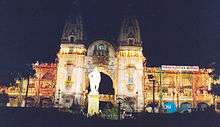
The two main institutions involved in planning and development in Vadodara are VMSS and the VUDA. The jurisdiction of both these agencies is demarcated clearly not only physically but also functionally. The governing acts for both the institutions differ. The principal responsibility of VUDA is to ensure a holistic development of the Vadodara agglomeration covering an area of 714.56 km2 (275.89 sq mi),[1] whereas VMSS is involved in the development of area of 235 km2 (91 sq mi).[1]
Three corporators are elected from each ward, who in turn elect a mayor. Executive powers are vested in the municipal commissioner, who is an IAS officer appointed by the Gujarat state government. The mayor is responsible for the day-to-day running of the city services, municipal school board, the city bus service, the municipal hospital and the city library. The Vadodara City Police is headed by a Police Commissioner, an IPS officer.
The City elects 1[4] member to the Lok Sabha (parliament) and 5[5] to the Gujarat Vidhan Sabha(Assembly) All of the 5 assembly seats of Vadodara were won by the BJP during the legislative elections in 2002. In the 2006 VMSS elections, the BJP won 74[21] seats, 6 seats went to the Congress.
- Election Wards: 38[1]
- Seats (Corporators): 114[1]
- Population per ward: 31,122
- Seats reserved for women: 38
- Total voters (as on 1 January 2019): 1,638,321
The Vadodara City Police are responsible for law enforcement and public safety in Vadodara, India. They are a subdivision of the state police force of Gujarat and are headed by a commissioner. The Vadodara police force is responsible for the protection and safety of Vadodara citizens. Shri Anupam Singh Gahlaut is the current Commissioner of Vadodara City Police.[22]
Transport
The city is on the major rail and road arteries joining Mumbai with Delhi and Mumbai with Ahmedabad.
Air
Vadodara Airport (IATA: BDQ) is located north-east of the city. Vadodara has flight connections with Mumbai,New Delhi and Bangalore. Air India and IndiGo are currently operating their services from the airport. A new integrated international terminal has been constructed at the Vadodara airport and was inaugurated in October 2016. Vadodara is the first Green Airport in Gujarat and Second Green Airport in India after Kochi.[23][24][25][26][27]
Railway
Vadodara was part of the historic Bombay, Baroda and Central India Railway (BBCI), which arrived in the city in January 1861.[28] On 5 November 1951 the BBCI Railway was merged with the Saurashtra, Rajputana and Jaipur railways to create the Western Railway. Vadodara Railway Station now belongs to the Western Railway zone of Indian Railways and is a major junction on the Western Railway Main Line.
The under-construction Mumbai–Ahmedabad high-speed rail corridor, India's first High-speed rail line will have a stop at the existing Vadodara Junction railway station. The station is planned for renovation to accommodate the new line.[29]
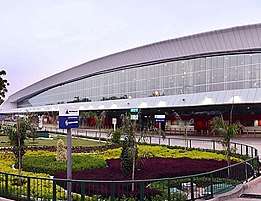 Vadodara Airport
Vadodara Airport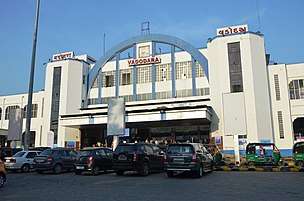 Vadodara Junction Railway Station
Vadodara Junction Railway Station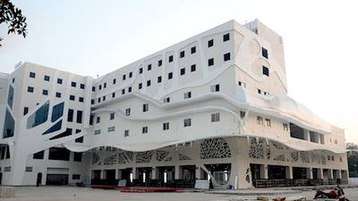 Bus terminus in Vadodara
Bus terminus in Vadodara
Demographics
According to the 2011 India census, Vadodara metropolitan area had a population of 1,822,221. In Vadodara, 9% of the population is under 6 years of age.[30] Gujarati, Urdu, Marathi, Hindi and English are the languages spoken in the city. Males constitute 52% of the population and females 48%.
| Population Growth of Vadodara | |||
|---|---|---|---|
| Census | Population | %± | |
| 1881 | 101,800 | — | |
| 1891 | 116,400 | 14.3% | |
| 1901 | 103,800 | −10.8% | |
| 1911 | 99,300 | −4.3% | |
| 1921 | 94,700 | −4.6% | |
| 1931 | 112,900 | 19.2% | |
| 1941 | 153,300 | 35.8% | |
| 1951 | 211,400 | 37.9% | |
| 1961 | 295,100 | 39.6% | |
| 1971 | 467,000 | 58.3% | |
| 1981 | 744,000 | 59.3% | |
| 1991 | 1,126,800 | 51.5% | |
| 2001 | 1,491,045 | 32.3% | |
| 2011 | 1,822,221 | 22.2% | |
| source:[31][32] | |||
Religions and festivals
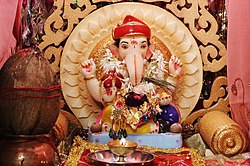
The most followed religion in the city is Hinduism, practiced by 85% of the population. The second most followed religion is Islam, followed by 11% of the population. All other religious groups make up the remaining 4% of the population.[33]
Sports
Vadodara has a professional cricket team, the Baroda cricket team, as well as the oldest cricket ground in Asia, called Moti Baug.[34] The team has won the Ranji Trophy six times. Reliance Stadium, a private cricket ground owned by Reliance Industries, hosts ODIs. Some of the notable cricketer's from Baroda are Kiran More, Nayan Mongia, Atul Bedade, Irfan Pathan, Yusuf Pathan, Hardik Pandya, Krunal Pandya, Deepak Hooda.
Media
The city has five local FM stations: Radio City (91.1 MHz), Radio Mirchi (98.3 MHz), Red FM (93.5 MHz), Big FM (92.7 MHz), and All India Radio, Vividh Bharti (93.9 MHz)(Aakashwani). Radio City (91.1 MHz) is known all over Vadodara for its Rag Rag Ma Vadodara City profile. All India Radio is broadcast on the AM band.[35] Satellite radio was launched in nearby city of Ahmedabad by WorldSpace in 2005.[36] Vadodara News Magazine(VNM) is a local news TV channel that covers events in the city. Sandesh News is a local news TV channel.
Temple
A non-sectarian Temple[37] inspired by Akram Vignani, Dada Bhagwan located near Babaria college, NH 48.
An EME Temple Located in Fatehgunj
Education
The city houses many Schools and Colleges. Higher Education Institutions across various disciplines attract international students mainly from the African countries such as Ethiopia, Zimbabwe, Malawi, South Africa, and Kenya.[38]
Universities
References
- "Institutional Setup in Vadodara" (PDF). Vadodara Municipal Corporation. Archived from the original (PDF) on 29 September 2007. Retrieved 29 July 2007.
- "Ward Office Details". Vadodara Municipal Corporation. Archived from the original on 2 October 2017. Retrieved 1 October 2017.
- Cities having population 1 lakh and above, Census 2011 Archived 23 July 2013 at the Wayback Machine. censusindia.gov.in
- "List of Lok Sabha Constituencies from Gujarat". Gujarat Assembly. Archived from the original on 2 March 2005. Retrieved 1 October 2017.
- "List of MLAs from Vadodara District". Gujarat Assembly. Archived from the original on 24 September 2015. Retrieved 30 June 2007.
- "About Vadodara". www.baroda.com. Archived from the original on 11 April 2019. Retrieved 11 April 2019.
- Vadodara Municipal Corporation
- "Hand Painting of Bridge over the River Vishwamitri, near Brodera". Collect Britain, British Library. Archived from the original on 28 September 2007. Retrieved 3 July 2007.
- "Village of Baroda" (PDF). Berrien County Community Development Department, Michigan. Archived from the original (PDF) on 27 September 2007. Retrieved 27 June 2007.
- "History of Vadodara – Baroda". Introduction | History of Vadodara – Baroda. Archived from the original on 2 January 2016. Retrieved 17 March 2015.
- "Gujarat Earthquake Hazard Risk Zone". Gujarat State Disaster Management Authority. Archived from the original on 29 September 2007. Retrieved 23 August 2006.
- "Baroda, India (2~35 kilometers)". Archived from the original on 11 December 2013. Retrieved 6 August 2013.
- "Gujarat Floods 2005: Project Report" (PDF). International Association for Human Values and the Art of Living. 2005. Archived (PDF) from the original on 12 January 2016. Retrieved 2 November 2015.
- "Vadodara May Weather 2016 – AccuWeather Forecast for Gujarat India". Archived from the original on 30 September 2016. Retrieved 26 November 2016.
- "Ever Recorded Maximum/Minimum Temperature up to 2010" (PDF). India Meteorological Department. Archived from the original (PDF) on 16 March 2014. Retrieved 16 March 2014.
- "Climate of Vadodara" (PDF). India meteorological department. Archived from the original (PDF) on 13 April 2015. Retrieved 31 May 2014.
- "Corporate > About Us > Worldwide Presence > India". Bombardier.com. Archived from the original on 1 June 2012. Retrieved 26 May 2012.
- MasterCard launches technology hub in India with facilities in Pune and Vadodara – The Economic Times Archived 7 February 2015 at the Wayback Machine. Economictimes.indiatimes.com (5 February 2015). Retrieved on 10 October 2015.
- Switch conference at Vadodara in October – The Times of India Archived 9 August 2016 at the Wayback Machine. timesofindia.indiatimes.com (1 August 2016).
- "Archived copy". Archived from the original on 20 September 2018. Retrieved 20 September 2018.CS1 maint: archived copy as title (link)
- "Sweeping victory for BJP in Gujarat civic polls". Chennai, India: The Hindu Daily. 14 December 2005. Archived from the original on 1 October 2007. Retrieved 9 July 2007.
- "Vadodara City Police – Details". cpvadodara.gujarat.gov.in. Archived from the original on 22 March 2019. Retrieved 22 March 2019.
- "Vadodara's new airport makes place in Limca Record". Dnasyndication.com. Archived from the original on 10 May 2017. Retrieved 26 November 2016.
- Dave, Vimukt (22 October 2016). "Vadodara gets India's second green airport after Kochi". Archived from the original on 23 October 2016. Retrieved 26 November 2016 – via Business Standard.
- "PM Narendra Modi inaugurates Vadodara International Airport – Times of India ►". The Times of India. Archived from the original on 18 May 2017. Retrieved 10 April 2019.
- "Vadodara Airport -[FSA]-". Archived from the original on 21 April 2016. Retrieved 26 November 2016.
- "Vadodara International Airport – Projects – Gensler". Archived from the original on 14 November 2016. Retrieved 26 November 2016.
- Sharma, Sachin (23 December 2009). "150th year of Railway in Vadodara". Times of India. Retrieved 24 December 2009.
- "Mumbai-Ahmedabad bullet train project: Construction work on swanky Vadodara railway station to begin soon". The Financial Express. 14 December 2018. Retrieved 2 March 2020.
- Vadodara City Census 2011 data Archived 22 May 2012 at the Wayback Machine. Census2011.co.in. Retrieved on 10 October 2015.
- "Historical Census of India". Archived from the original on 17 February 2013. Retrieved 23 March 2014.
- "Census of World". Archived from the original on 2 April 2016. Retrieved 23 March 2014.
- "Vadodara City Population Census 2011–2019 – Gujarat". www.census2011.co.in. Archived from the original on 22 May 2012. Retrieved 12 June 2012.
- "Ground Profile". Cricinfo. Archived from the original on 28 December 2008. Retrieved 17 November 2008.
- "Radio Stations in Gujarat, India". Asiawaves. Archived from the original on 27 May 2007. Retrieved 14 June 2007.
- "WorldSpace Satellite Radio Lights Up Ahmedabad". Worldspace Satellite Radio. 3 November 2005. Archived from the original on 12 November 2006. Retrieved 30 July 2006.
- "About Temple". www.trimandir.org. Retrieved 8 March 2020.
- "Gujarat: More foreign students opt for MS University of Baroda". The Indian Express. 28 July 2019. Retrieved 27 September 2019.
Further reading
- Desai, Anjali. India Guide, Gujarat – Visitor's Guide. India Guide Publications. ISBN 0-9789517-0-0.
- F. A. H Elliot. The rulers of Baroda. Baroda State Press 1934. ASIN B0006C35QS.
- Gense, James. The Gaikwads of Baroda. D.B. Taraporevala Sons & Co 1942. ASIN B0007K1PL6.
- Kothekara, Santa. The Gaikwads of Baroda and the East India Company, 1770–1820. Nagpur University. ASIN B0006D2LAI.
- Gaekwad, Fatesinghrao. Sayajirao of Baroda: The Prince and the Man. Popular Prakashan. ISBN 978-0-86132-214-5.
- Gaekwar, Sayaji Rao. Speeches and addresses of Sayaji Rao III, Maharaja Gaekwar of Baroda. H. Milford 1933. ASIN B000855T0I.
- Rice, Stanley. Life of Sayaji Rao III, Maharaja of Baroda. Oxford University Press 1931. ASIN B00085DDFG.
- Clair, Edward. A Year with the Gaekwar of Baroda. D. Estes & co 1911. ASIN B0008BLVV8.
- MacLeod, John. Sovereignty, Power, Control: Politics in the State of Western India, 1916–1947. Brill Academic Publishers. ISBN 90-04-11343-6.
- Kamerkar, Mani. British Paramountcy: British-Baroda Relations, 1818–1848. Popular Prakashan. ASIN B000JLZE6A.
- Kooiman, Dick. Communalism and Indian Princely States: Travancore, Baroda and Hyderabad in the 1930s. Manohar Pubns. ISBN 978-81-7304-421-2.
- Desai, Govindbhai. Forty Years in Baroda: Being Reminiscences of Forty Years' Service in the Baroda State. Pustakalaya Sahayak Sahakari Mandal 1929. ASIN B0006E18R4.
- Maharaja of Baroda. The Palaces of India. Viking Pr. ISBN 978-0-00-211678-7.
- Sadashiv, Anant. A History of important ancient towns & cities in Gujarat & Kathiawad. ASIN B0008B2NGA.
- William, George. Cities of India. Adamant Media Corporation. ISBN 0-543-93823-9.
- Doshi, Saryu. The royal bequest: Art treasures of the Baroda Museum and Picture Gallery. India Book House. ISBN 978-81-7508-009-6.
- Roshan. Sri Aurobindo in Baroda. Sri Aurobindo Ashram Publications Department. ISBN 978-81-7058-318-9.
- Sheik, Gulammohammed. Contemporary Art in Baroda. Manohar Pubns. ISBN 978-81-85229-04-1.
- Bell, Horace. Railway Policy in India. Adamant Media Corporation. ISBN 1-4021-8443-3.
- Shafer, Kathleen. Baroda: the Story of a Small Place. Celebrate Baroda 1890–1990. Baroda Centennial Committee, Michigan, United States. ASIN B000K016MG.

